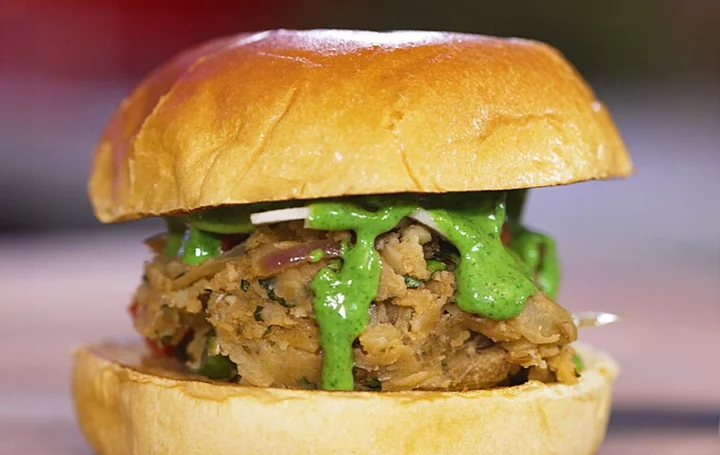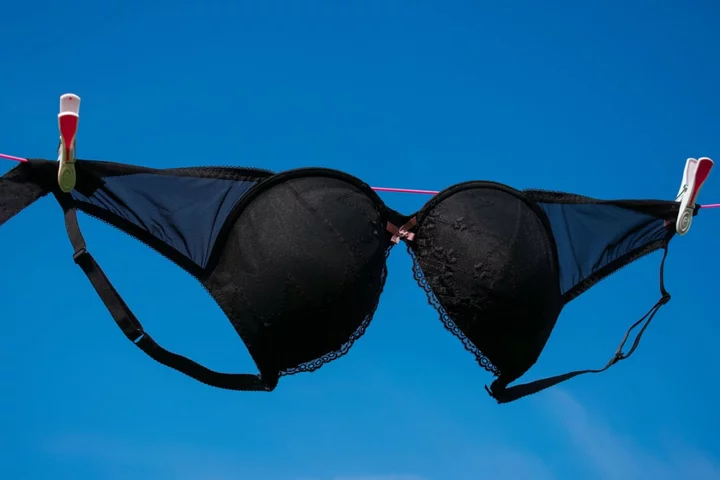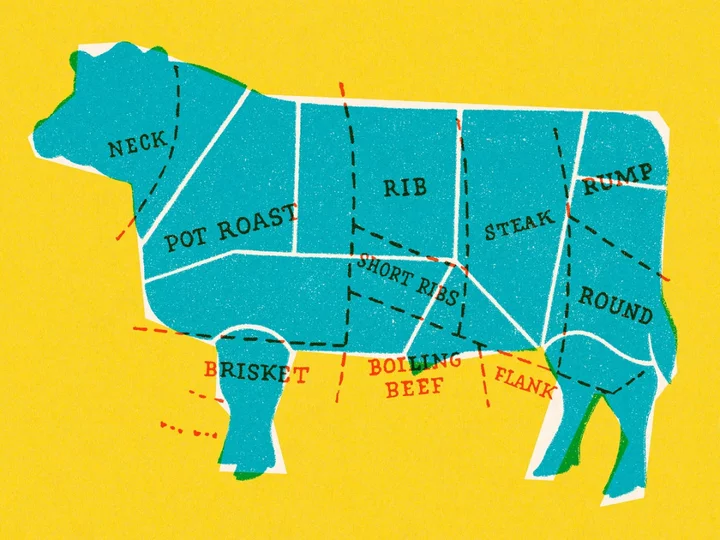
Attention, Shoppers: Wawa Is Now Serving Pizza
The mythical Philly-based convenience store chain is now offering freshly-prepared pizza. But will anyone bite?
2023-08-01 03:25

The Invisible Climate Impact of a Cruise Ship
Cruise operators are replacing oil-based fuel with liquefied natural gas to run their ships and pitching the shift
2023-07-31 21:52

London chef apologises after criticism for all-white, all-male kitchen team
A London-based chef has apologised for what his peers branded a “rude” response towards criticism, after he faced backlash online for revealing the line-up of his kitchen team at his Notting Hill restaurant. Thomas Straker, who opened his namesake restaurant Straker’s in 2022, recently shared a photograph of his “chef team” comprising eight people, including himself. All eight members of the team pictured were white and male, prompting complaints from social media users who believed it did not reflect the diversity of London. Some comments claimed Straker’s team showed how the food industry was a “white boy’s club”, while others urged the restaurateur to provide chefs from minority groups a “safe place to grow as chefs”. Straker, who found fame by sharing his recipes and cooking videos on TikTok, responded to the negative backlash by commenting: “Honestly, people need to calm down. Firstly, there is a shortage of chefs/hospitality workers. Secondly, if you feel so passionately, please go and gather CVs of any chefs you think we’re missing in the team. Solutions not problems. Thank you.” However, his response has also been criticised as “rude”, with a number of chefs and other figures in the food industry weighing in on the online storm. He has since shared an apology via his Instagram Story. “On Friday night, I put up a post of my chef team and many rightly pointed out the lack of diversity in it. I am very sorry for my initial response, where some queried whether I take this issue seriously,” he said. “I am absolutely committed to ensuring diversity in my restaurants, unfortunately we aren’t achieving this in my kitchens currently and this is an area I know I need to improve on, making sure it is seen as a welcoming and approachable environment for all. Tom x.” Becky Paskin, a drinks expert who appears regularly on ITV’S Love Your Weekend, wrote on Straker’s original post: “Too often we say, ‘We only recruit on the basis of the best people for the job’ without any consideration the role bias plays in the selection process. “It’s been proven time and again that diverse teams are more creative, productive and successful. If every member looks the same and has the same background, you’ll find they’ll all think the same as well. Forming diverse teams is not only the right thing to do, it makes business sense too.” US chef Kenji Lopez-Alt, who is known for his book The Food Lab: Better Home Cooking Through Science, added: “Get off the social media for a week or so. Do some reflection. Talk to people who care about you and who you trust. Be better.” However, some people have defended Straker’s choice to hire who he wants in his team, and pointed out the staff shortage affecting the entire restaurant industry. Henry Tilley, restaurant manager at Native in London, wrote: “The industry is on its knees right now. There [aren’t] enough chefs or even [front-of-house staff] to go around as it is. We would love some applications for chef positions in our restaurants from female or non-binary individuals. The reality of the matter is we never get the applications so can’t be as representative as we’d like.” But Ben Mulock, executive chef of Balans in Soho, says the onus is on senior chefs to “solve the problem” of lack of diversity, instead of “asking others to solve it for us”. He told The Independent: “I am a white male executive chef, so it is my responsibility to push for an inclusive workforce, be that sex, age or ethnicity. They are not mutually exclusive – they are all important. “No, it’s not easy and at the moment, it almost seems impossible to recruit, but if we don’t try, we don’t move it forward. We always need to do better for this industry, and if we can’t do it in London, where can we?” While Straker’s post was not intended to stir controversy, the lack of diversity in his team has “shone a light on the broader challenges we face in kitchens these days”, Hannah Norris of Nourish PR said. “This is a classic case of an ill thought-out post,” she told The Independent. “Thomas Straker has issued what he believed was a photo of a group of confident, strong-looking chefs ready for service but didn’t think about the optics of the image and what it represented. “Whilst it was well-meaning I believe, a picture doesn’t lie. For whatever reason, he currently has no women or people of colour in his kitchen, so it all looks a bit ‘pale, male and stale’. Perhaps the reaction to this image will make Thomas think again a bit more carefully about who he wants to employ in the future.” The Independent has contacted Straker for comment. Read More The dish that defines me: Frank Yeung’s prawn wontons Between Brexit and Covid, London’s food scene has become a dog’s dinner – can it be saved? Prince William serves up vegetarian ‘Earthshot burgers’ to shocked diners Restaurant introduces ‘minimum spend’ that sees solo diners pay double to eat alone Restaurant with ‘tips are a privilege’ policy sparks intense backlash on social media How to make the Prince of Wales’s Earthshot burger
2023-07-31 21:24

How to dress in rainy summer weather
Following a record-breaking June, it’s fair to say summer has turned into a bit of a washout, with a deluge of downpours, while other parts of Europe are baking in unbearable heat. Unfortunately, the unsettled weather is set to continue, with the Met Office forecast for the next two weeks stating: “Showery conditions are likely, along with the risk of longer spells of rain and stronger winds at times too.” In the second half of August, we can expect: “A mixture of rain and showers for many areas… any prolonged dry and hot spells appear to be unlikely.” At the same time, temperatures haven’t plummeted completely, which makes deciding what to wear quite the conundrum at the moment. How do you keep cool and dry at the same time? Here’s what fashion experts recommend for wet weather during summer… Waterproof jacket When it’s too warm for a proper coat, a thin rain jacket with a hood is essential. Make a style statement in a bright colour or bold print, with trendy waterproofs that combine fashion and function. “A lightweight and compact rain jacket from Rains is always easy to style and perfect for carrying around for unexpected showers,” says Lesley Torson, co-founder of Trilogy Stores. “They look really sleek, so won’t ruin a good outfit, whilst still being really light and airy to keep you cool.” Amber Gordon, founder of fashion sourcing company Tailored Styling, recommends a see-through mac: “During Fashion Week, fashion editors and stylists will have a clear and structured raincoat they can whip on to keep their look from getting wet, that still allows people to see what they are wearing.” Regatta X Orla Kiely Summer Pack-It Jacket in Fuschia Passion Flower, £34.95 (was £70) Cotton Traders Moorland Rich Gold Waterproof Coat, £65; Wrinkle Free 3/4 Sleeve Stripe Jersey Top, £20; Women’s Ecru Coloured Stretch Jeans, £36 (accessories, stylist’s own) Lots of layers “Light layers are the best way to dress for summer rain,” says Torson. “Wear your raincoat with a cropped jean, or cotton or linen midi dress, and trainers to maintain a summery look, whilst being prepared for unpredictable weather.” The utility trend is also handy for rainy days – loose cargo pants are cool and practical. “Whip out your hoodies and wear underneath an oversized leather blazer,” says Gordon. “The different textures will make the laidback and comfortable fit feel super high-end.” Monsoon Wide Leg Cropped Jeans in Blue, £80 Sensible shoes Nobody wants soggy socks, which is why splashproof shoes are a must – trainers with a chunky sole will help stop puddle water from seeping into the seams. For seriously rainy days, only Wellington boots will do. “They’re officially back as a fashion staple, thanks to this unpredictable rain,” says Gordon. “To elevate the welly look to luxury, invest in a lighter colour, like a beige or cream Wellington boot. Wear with a bare leg and a floaty dress that will keep you cool and looking summery.” Dune London Truro Navy Side-Stripe Lace-Up Runner Trainers, £100 Don’t forget your hat A hat is the most important fashion accessory for keeping your hair dry and frizz-free. “Hats have become incredibly popular this summer, from denim hats, such as the Miu Miu denim cowboy hat, to summery straw hats,” says Gordon. A water-resistant bucket hat is on-trend and ideal for drizzly days. “A tanned leather bucket will go with most outfits,” Gordon continues. “Use hats to dress your outfits up or down, depending on your mood and as a bonus – you’ll barely notice the rain!” Accessorize Nylon Bucket Hat, £14, Simply Be
2023-07-31 20:52

How to make the Prince of Wales’s Earthshot burger
The Prince of Wales has teamed up with popular YouTube channel, Sorted Food, to create the first Earthshot Burger. The veggie burger was created with Earthshot Prize-winning products, and a video posted on YouTube shows William handing out meals from a food van in central London with the Sorted Food chefs. The burger, filled with vegetables, spices, pickles and finished with a minty vegan mayonnaise, was developed by the sustainable packaging start-up Notpla (winner of the Build A Waste-Free World category), environmentally-friendly stove company Mukuru Clean Stoves (winner of the Clean Our Air category), and Kheyti’s Greenhouse-in-a-box, winner of the Protect and Restore Nature category. The collaboration is part of The Earthshot Prize’s new partnership with YouTube, to encourage users to create more content around climate change. Here’s how you can make your own at home… The Earthshot Burger Ingredients: (Serves 4) For the pickle: 1 cucumber, 2mm slices 1 mouli, peeled and cut into 2mm slices 200ml white wine vinegar 75g caster sugar 1tsp chilli flakes 1tbsp coriander seeds ½tbsp fennel seeds 1tsp mild chilli powder 1tbsp ground coriander seed 1tsp garam masala For the burger mix: 6tbsp vegetable oil 2tsp cumin seeds 1tsp mustard seeds, brown 1 red onion, peeled and finely chopped 6 cloves garlic, peeled and minced 40g ginger, finely chopped 2 green chillies, finely sliced 1tsp turmeric 1 red pepper, deseeded and sliced 200g white cabbage, shredded 200g cauliflower, finely chopped 100g green beans, finely sliced 500g white potato, steamed and cooled 30g coriander leaves, chopped For the sauce: 200g vegan mayonnaise 60g coriander 20g mint, leaves only 20g ginger, peeled To serve: 4 burger buns, sliced and toasted Method: For the pickle: 1. Place the sliced cucumber, mouli and one tablespoon salt in a large mixing bowl and mix well. Allow to sit for 30 minutes. 2. Add 400 millilitres water, vinegar, sugar and spices to a medium saucepan and bring to a simmer over a high heat. Once simmering, remove the pan from the stove. 3. After 30 minutes, tip the salted cucumber and mouli into a colander and rinse under cold running water then add them to the warm pickle liquid. Stir well and allow to cool. For the burger mix: 4. Heat the oil in a large saucepan over a medium heat. Add the cumin seeds and mustard seeds and fry for two minutes until fragrant and starting to pop. 5. Add the onion, garlic, ginger and chillies, along with a pinch of salt and continue to fry, stirring occasionally for five to seven minutes until the onion is starting to colour. 6. Tip in the spices and stir to combine. 7. Tip in the sliced pepper and continue to cook for five minutes until the pepper softens and releases its liquid. 8. Add in the cabbage, cauliflower and green beans, stir everything together and cover the pan with a lid. Allow the vegetables to soften for five minutes. 9. Coarsely mash the potatoes in a bowl and then add them, along with the coriander to the pan. Stir everything together and taste and adjust the seasoning. You are looking for a thick mashed potato texture. 10. Remove the pan from the stove. For the sauce: 11. Add the mayonnaise, herbs, ginger and a generous pinch of salt to the jug of a blender and puree until smooth. Taste and adjust the seasoning. To serve: 12. Divide the mashed potato and vegetable filling between the toasted buns. Top each with a couple of pinches of pickled vegetables and finish with the herb sauce. Read More ‘Nicely cooked’: Watch moment Prince of Wales serves burgers to surprised diners in London The dish that defines me: Frank Yeung’s prawn wontons Seann Walsh explains reason behind his ‘strange request’ at restaurants
2023-07-31 20:26

Christian Cowan launches limited edition Candy Crush beanbag dress
Designer Christian Cowan has done it again, with a creative garment for commuters everywhere. Enter, The Sweet Seat. The limited edition collaboration with Candy Crush Saga is inspired by the dreaded morning commute in the city. It offers a wearable seat adorned with bright colours and shapes taken from the popular game. Cowan, best known for his bold and unexpected collections, has worked with Candy Crush to put his playful and humorous touch on the Sweet Seat, bringing it to life in a way that doesn’t compromise fashion for comfort. His approach provides a sweet solution that puts the fun back in functional. With campy and Candy-tastic designs, the piece blends Cowan’s creativity and high fashion prowess with Candy Crush’s world of fun colours, candies and patterns. Sign up for our free Indy100 weekly newsletter "This piece is inspired by the fun that Candy Crush brings to mundane tasks like commuting," Cowan said. "Public transit could use a dose of glamour, especially in New York City and London, and the Sweet Seat brings that glamour in a fun, fashionable, and over-the-top way. What I love about this collaboration is that it brings a joyful solution to an everyday problem in a way that’s both out-of-the-box and camp." The Sweet Seat features a tear-drop silhouette garment that can be worn solo as a dress, or over the top of an outfit as an accessory. Functionally, the garment works like a bean bag, the wearer can literally sit back and take a seat anywhere they’d like. "Our loyal fans who play Candy Crush on the go love the colour and fun that we bring to their everyday lives," said Luken Aragon, VP of marketing at Candy Crush Saga. "Whether they’re waiting in a long queue or battling the daily commute - without a seat, we want to be able to help bring them that joy and vibrancy to their day so that nothing gets in the way of levelling up. Collaborating with Christian to bring to life the candies that these players know and love - and can now wear - has been truly divine." This limited-edition item is available for purchase for $1,000 / £786.92. Have your say in our news democracy. Click the upvote icon at the top of the page to help raise this article through the indy100 rankings.
2023-07-31 20:20

Has America’s Air Travel Boom Peaked?
The air travel boom in the US appears to be fading. Purchases by US consumers directly from major
2023-07-31 17:56

Priya Ahluwalia: I’m so much more than just a ‘sustainable designer’
When fashion designer Priya Ahluwalia walked into the dress rehearsal of her autumn/winter 2023 London Fashion Week show in February, she couldn’t stop crying. Titled Symphony, the show was staged at a formerly baroque church hall, with models walking to jazz-infused renditions played by pianist Insxght and saxophonist Solaariss. “I was just so emotional,” the 30-year-old founder and creative director of Ahluwalia says. “It was like the culmination of a big deep dive coming together. That’s how I felt.” Ahluwalia rediscovered the music of her youth when designing the collection. “I don’t like to do things in an obvious way,” Ahluwalia admits. “As life changes, you listen to different things at different stages, so I thought about the visuals of what music sounds like when designing Symphony. “I Will Always Love You by Whitney Houston was on the radio when I was born. So my mum finds that song really special and played it to me a lot. Sade’s Kiss Of Life was quite informative, and 50 Cent was also in there too. I remember getting one of his albums when I was 10 and thinking it was phenomenal. I also thought a lot about Prince, Queen, Freddie Mercury and even traditional Punjabi music.” Sound waves and musical notes inspired the lasered print on denim, jacquard patterns on mohair knitwear and track tops with accompanying shorts. Earthy shadows, reds and ochres were taken from the colours of album covers and illuminated cotton separates. Ahluwalia launched her eponymous fashion label in 2018 after graduating from the MA Menswear course at the University of Westminster, combining her dual Indian-Nigerian heritage and London roots, while also exploring the potential of vintage and surplus clothing. Around that time, Ahluwalia visited her father in Nigeria and says she noticed “paupers” wearing secondhand clothing from the UK. “I was really confused and started to ask questions about it,” she says – and it led to the publishing of her first book, Sweet Lassi, exploring the secondhand clothing industry in the Global South. “Finding ways for people to cherish their clothing forever has always been important to me,” Ahluwalia says. “Microsoft and I worked on a platform called Circulate in 2021, where we use AI to crowdsource and categorise people’s unwanted clothing. But now, I think consumers really see the value in learning about the things that happen behind the scenes of the clothes they are purchasing.” It’s why individual garments from the Symphony collection feature Digital ID technology — created and connected by the EON Product Cloud platform, powered by Microsoft Azure. Ahluwalia customers can scan with their mobile phones to discover their item’s unique story, including the design inspiration, production processes and origins of the sourced materials, helping consumers better understand how their clothes can be resold, reused and recycled. “This gives us the opportunity to really share exclusive content and information about a product. As a contemporary luxury brand selling items that are around £400, it’s important to provide our customers with more value and share the stories behind their clothes, whilst encouraging them to engage with sustainability.” But Ahluwalia doesn’t want to be pigeonholed as a sustainable designer. “I’m so much more than making the right choices,” she says. “I’m a designer first and foremost, who is also a creative director, filmmaker of Joy and Beloved, who works sustainably to explore and redefine the inherent beauty of blackness [and brownness] through an authentic lens. “The vision is that one day someone would be sitting on Ahluwalia in their front room, watching it, wearing it, smelling it and eating it. A whole 360. I would love Ahluwalia to be an example of how ideas that are not so rooted in Eurocentric values are expandable and amazing on a global stage for people to interact with in a global sense, like we see with many traditional European [fashion] houses.” So what’s next for the fashion house? “We’re doing a show at London Fashion Week in September, but I can’t tell you anything about it. The only thing that I can tell you is that we’re holding the show at the British Library, which I’m really excited about.” Discover more about Ahluwalia’s partnership with Microsoft and EON here: Ahluwalia Symphony Unlocked | Microsoft Unlocked. Read More Charity boss speaks out over ‘traumatic’ encounter with royal aide Ukraine war’s heaviest fight rages in east - follow live Experts reveal why you keep waking up at 4am, and how you can prevent it 10 last-minute gardening jobs before you go on holiday How often should you wash your bra?
2023-07-31 17:52

The dish that defines me: Frank Yeung’s prawn wontons
Defining Dishes is an IndyEats column that explores the significance of food at key moments in our lives. From recipes that have been passed down for generations, to flavours that hold a special place in our hearts, food shapes every part of our lives in ways we might not have ever imagined. There is a family scene I would love to engrave into my memory that involves my father, myself and my son, all making prawn wontons in one kitchen. Prawn wontons are so simple, like all good dishes, and they have a really special place in my heart. I have very fond memories of making them with my father, who is from Hong Kong, when I was growing up and it is my favourite dish. Now, it’s my five-year-old son’s favourite dish as well and he’s the same age I was when I first started making prawn wontons with my father, so it makes me excited to share the dish with him. When my son was younger, his Ye Ye (grandfather) would bring homemade wontons whenever he came over to my house in Peckham. But just recently, we were over at my parents’ home, and he made his first wonton. We were all very proud! It’s so nice because it’s a dish that has run right through my family, it was brought and championed here by my dad. He moved here in 1975 and has the classic first-generation immigrant story. He worked three jobs, moved around a lot, saved money and opened his first restaurant in 1985, 10 years after arriving in England. He finally retired in 2017, but he couldn’t get away from my restaurants. I opened my own establishment, Mr Bao in Peckham in 2016, and then Daddy Bao in my father’s honour. Even now when he comes around to visit, I make him talk more about restaurants. I think he enjoys it, though, and it reminds him of home. That’s really important now because ever since the 2019-2020 mass protests in Hong Kong, the country is a sad place at the moment if you’re from there. But it’s still an amazing place. My favourite part about making wontons from scratch was always the time spent with my dad. The chit chat between us, me kneeling on a stool and him standing at the counter. My hands were not as dextrous at that age and I certainly wasn’t practised, but he would be there to help show the right way to make the little parcels and finish them up for me. The bonding moment is what I cherish the most. Mum is English and she got involved too, she is actually amazing at it. Prawn wontons are also part of Christmas time for my family. Our big tradition is to have a massive steamboat on Boxing Day, which most people of Chinese descent will be familiar with. It usually involves a big, steaming pot of soup on a constant boil, and everyone sits around the table cooking fresh, raw ingredients in it and eating as they go. Prawn wontons are a big, big part of that meal for us, especially now that we have a couple of young kids running around at Christmas time, they really love it. The thing I remember most about making wontons with Dad is the filling. He has his own method for making the prawn mince that goes inside the parcels. He gets his prawns and chops them up, mixes them with any additional ingredients like garlic, and then he would make me pick up a handful of the mixture and throw it back down onto the chopping board, pick it up and throw it back down. It somehow aerates the mince and softens it, and makes it stickier so there aren’t big chunks of prawns floating around. I haven’t really adapted Dad’s recipe for myself, aside from the type of dipping sauce I like to have with them. We keep it very traditional. Oh, I suppose I do have a slight modification, actually. I like to mix gambas (white) prawns from the southwest coast of Spain with North Atlantic shrimps, which are tiny, tiny little crustaceans the size of your nail. They have got a really good flavour. I like to chop those up into the mince with the bigger prawns, add a bit of salt and white pepper, stir it through and then do the throwing method as my dad does. We usually make our own wonton skins. In a pinch, we’ll use shop-bought ones, but when we know we’ve got time we’ll make our own. At the moment, Dad makes handmade dumplings with my sister for her business so they have a dumpling skins machine – but we used to make them by hand, old-school style. He would roll them out because he could get the thickness of the skins right. It wasn’t possible when I was young as I had no idea and was clumsy! They have to be thin, but not so thin that they break or the wontons will open up in the water. It’s something I haven’t managed to master, but there’s still time. Some places don’t even use the regular wonton skins, and they are still amazing. One of my favourite restaurants ever was in Hong Kong – it has closed down now – but it was a hole-in-the-wall type of place that served two types of wontons: classic wontons or fish skin wontons. That was their entire menu. They used fish skins instead of pastry skins to wrap their wontons, and they were something like £1.20 for a bowl at the time. It was definitely the best meal I had with Mum, Dad and my sisters in Hong Kong. The wontons get boiled for two minutes. You can make a wonton soup with a base stock, using ginger, spring onions, salt, pork bones. Boil that down and skim off the top. Or, you can dip the wontons into a chili garlic sauce, which is how my dad likes – although another way I differ from Dad is that I like to add black vinegar to the sauce of soy sauce, garlic and chili, to add an extra layer of acid. You can also eat them as they are, they are completely delicious. My stomach is rumbling as I think about them. As my son gets older, it will be really nice to be able to make wontons altogether, the three generations of us at the kitchen island, chatting away. That’s what I’d like my son to take away from those sessions, the memory of doing it with his Ye Ye and me. I’d also like him to, in time, be able to link quality to food and what you’re putting in your body. I want him to understand that even though it’s so easy to go to the shop and buy something, everything starts out as a living thing. A prawn is an animal and a chive is a real plant grown in the soil. You don’t have to make it yourself and you should go to restaurants to support them, but when you do go, you’ll have a better appreciation for it. Frank Yeung is the chef-owner of Mr Bao and Daddy Bao in London. Read More The dish that defines me: Alex Outhwaite’s Vietnamese bun cha The dish that defines me: Eddie Huang’s Taiwanese beef noodle soup In Horto: Hearty, outdoorsy fare in a secret London Bridge garden Five dinner ideas from around the world to try this week Hi Barbie! Nine cocktails inspired by the doll’s most iconic outfits
2023-07-31 17:20

Experts reveal why you keep waking up at 4am, and how you can prevent it
Ever find yourself awake, staring into space at four in the morning? Is it just a bad habit, or is there something more sinister going on? And why does it always seem to happen at 4am? “We start to experience less deep sleep after around four to five hours,” says Lisa Artis, deputy CEO of The Sleep Charity, who have partnered with Simba mattresses. And once we’re in that lighter sleep faze, we wake much more easily. If you generally fall asleep around 11pm – which is a very common bedtime, 4am wake-ups are more likely. And there are many factors leading to these inconvenient stirrings. Hormones “Sleep is guided by our internal clock or circadian rhythm. One of the most significant and well-known circadian rhythms is the sleep-wake cycle,” Artis continues. “Sleep is regulated by the levels of two hormones: melatonin and cortisol, which follow a regular 24-hour pattern. Melatonin assists you in dozing off, while cortisol helps get you up, and keeps you awake,” she explains. Keeping an eye on your hormones is important in preventing those late-night wake-ups. “Engage in calming activities before bedtime, such as reading, listening to soothing music, or practising relaxation techniques, like deep breathing or meditation,” says Dr Mariyam H. Malik, GP at Pall Mall Medical. Equally, pop your phone down for a bit. “Blue light from electronic devices can suppress melatonin production. Try to avoid screens for at least two hours before bedtime, or use blue light filters. It is best to charge them in a separate room overnight,” Malik adds. Diet Caffeine, heavy meals, alcohol, sugar, and a lack of magnesium or B vitamins could lead you to have a more disturbed night’s sleep, according to Malik. Sugar and carbohydrates may have a particular impact. “A diet high in sugar and refined carbohydrates can cause blood sugar fluctuations, leading to wakefulness during the night,” she says. “It’s unlikely you’ll feel hungry in the middle of the night if your blood sugar dips,” notes Artis, “but to reduce ungodly hour awakenings, trial alternatives for your last meal or snack of the evening. Instead of carb or sweet-based snacks, opt for protein-packed and magnesium-rich foods, like hard boiled eggs, cottage cheese, pumpkin seeds, spinach, dark chocolate, cashews, chicken thighs or turkey.” Protein can take the edge off your night-time hunger, she says, while magnesium is known to support sleep. Needing a wee Do you wake up needing to wee at the same time every night? “Try not to drink excessive amounts of fluids before bedtime,” advises Malik. “It’s important to stay hydrated, but try not to drink anything for around two hours before your usual bedtime. Go to the toilet before you go to bed to empty your bladder. ” Age and life stage “Sleep tends to become more disrupted as people get older,” Malik explains. “Sleep patterns change with age, and various factors can contribute to sleep disturbances in older adults. Some common reasons for sleep disruption in the elderly include changes in your circadian rhythm, decreased melatonin production, medical conditions or medications, and potential sleep disorders.” It can also affect women during the perimenopause. “The reproductive hormones – oestrogen and progesterone – are entwined with the sleep and relaxation hormones, melatonin and serotonin,” says Artis. “When oestrogen begins to fall before and during menopause, it can create a disturbance in the sleep-promoting hormone melatonin, meaning it can’t properly balance out cortisol. When this happens, the ability to fall and stay asleep is affected.” Recurring hot flushes, night sweats, dry skin, and low libido can signal waning oestrogen. Artis advises incorporating foods with high levels of phytoestrogens into your diet throughout the day to help with this. “Phytoestrogens imitate the natural estrogens found in your body. As a consequence, they can bind to your body’s oestrogen receptors and produce similar effects.” Try lentils, kidney beans, chickpeas, tofu, edamame, spinach, cauliflower and broccoli. Worrying Stress is not good for sleep. One study by Bupa even found that 32 million Brits wake up worrying about their health at precisely 4:05 am. The report, which surveyed 4,000 British adults, revealed that more than three-fifths of us wake up in the middle of the night. If you are finding yourself awake at all hours worrying, or waking up with stressful dreams, there are a few things that may help. “Keep a journal by your bedside and write down your worries before going to bed. This practice can help get your concerns out of your mind and onto paper, making it easier to let go of them temporarily,” says Malik. You may also want to “engage in mindfulness or meditation exercises before bedtime. Mindfulness can help you focus on the present moment, reducing anxiety about the past or the future.” Read More Men have a problem – and it won’t be solved by either Andrew Tate or Caitlin Moran Elon Musk reacts to ex-wife Talulah Riley’s engagement to Thomas Brodie-Sangster Thomas Brodie-Sangster references Love Actually in sweet engagement announcement with Talulah Riley Charity boss speaks out over ‘traumatic’ encounter with royal aide Ukraine war’s heaviest fight rages in east - follow live
2023-07-31 17:19

How often should you wash your bra?
Summer and smalls… it’s the yin and yang of our wash-day world. You’ve got a bit hot and sweaty at lunchtime, but you’ve only worn your favourite lacy bralette once… so it’s OK to put it back in the drawer, right? And then there’s the sports bra in your gym bag – it’s looking a little bit grubby but you can’t remember perspiring in your Pilates class. Here, experts shed some light on how you should be looking after your lingerie, along with some do’s and don’ts… How often should you wash your bra? “Realistically, if your bra hasn’t been worn for sports or on a particularly hot day, then we would advise washing every three to four wears,” says Rachael Burdis, product and marketing assistant at Pretty Polly. “If you leave it too long, then it will allow bacteria to build up and you could get dreaded boob spots; or even worse your bra could start to smell,” warns Burdis. Do you need to hand wash your bra or can you put it in the washing machine? We’ve all read the small print… some labels recommend hand washing but is this really necessary? Fabric plays a huge part in not only how often, but also how you wash your bras, says Burdis. “We all know bras are delicate garments and ideally, we should be hand-washing them each time in warm water – this keeps the bras’ shape and maintains the quality of the materials used. “However, I think we can all say we’re guilty of not doing that all the time – but we should try our best!” With fine fabrics like silk and fragile laces, she says they should always be hand-washed to avoid any additional wear and tear. If you’re pushed for time and your bra is going in the washing machine, Dinara Akhmerova, senior manager UK and Ireland for Simone Pérèle, advocates a detergent made specifically for delicates. “We recommend you don’t add softener as it can stay in the fibres for longer and reduce elasticity. Also, wash on a delicates setting at maximum 30C and no more than 800 RPM spin.” She also suggest using a bra wash bag to protect your underwired bras – and always dry lingerie flat to keep the shape. Does it matter if you wear the same bra for a week, even in summer? “We wouldn’t advise wearing a bra for a week; whether that be summer or winter, just to avoid any bacteria build-up,” says Burdis. “We also know length of time worn plays a huge part when deciding when to wash your bra.” If it’s been for a couple of hours a day, she says you could have a week’s worth of wear. But for a full day’s wear, she wouldn’t advise wearing your bra for a week. For matching sets, should you always wash knickers and bras together, so they don’t become different shades? “We tend to wash our knickers more often than bras – and good-quality lingerie shouldn’t fade so dramatically that you can see a marked difference, simply from not washing them together on a few occasions,” says Akhmerova. However, how well your lingerie maintains its colour depends on many factors, such as how careful you are when washing it, the type of fabric and colour, suggests Akhmerova. “Whether you wash your sets together or not, the number one rule is to always separate colours, especially your whites. Just don’t mix the colours! “Also, don’t use bleach on whites,” she warns. “It’s more likely to turn lingerie yellow than brighten it.” What about sports bras? For sports bras, Burdis sees this a little differently: “With a less intense low-impact workout, we advise every two wears. “But when it comes to a heavy gym session, long run or HIIT class, we advise after each wear to ensure you are always smelling fresh – and the bra isn’t accumulating bacteria.” Should you wash you underwear before wearing it, if it’s brand new? “Underwear should leave factories or packing houses clean as strict hygiene rules are in place,” says Akhmerova. “But it never hurts to give it a rinse out before the first wear.” Read More Charity boss speaks out over ‘traumatic’ encounter with royal aide Ukraine war’s heaviest fight rages in east - follow live 5 late summer blooms to plant now This is why you keep waking up at 4am – and what you can do about it The two best exercises for lowering blood pressure, according to study
2023-07-31 15:15

Blood, guts and cheap cuts: We need an alternative to eating animals – and ‘ethical meat’ isn’t the answer
Amber Husain was cooking dinner for a friend when she suddenly realised the meat she was preparing was a corpse. She looked at the chicken in front of her and was overcome with a visceral sense of disgust. Instead of food, she saw “a carcass – plucked, beheaded, and fleshy”. Husain was 26 when she had this epiphany, and it served as a wake-up call not just for her stomach but her mind, too – as her personal tastes shifted away from meat products, her political outlook on the meat industry and food production more broadly also altered and expanded. Five years later, that moment of revulsion forms the opening of her new book, Meat Love, in which she scrutinises the idea of “ethical” meat consumption, and dares to ask how the contemporary middle classes have come to criticise “the worst violence against animals” while still happily feeding on their flesh. Why, for example, has well-heeled, middle-class London gone nuts for slurping bone marrow from the shin bones of baby cows? Why is offal on so many trendy menus? How has contemporary culture at large come to accept that factory farms are monstrous, but that if animals are cared for, cherished and loved while alive, we should feel better about killing them for our carnivorous pleasures? “For ages, I was one of those carnivores who felt mildly bad about eating meat but just turned that into this inane, self-consciously sadistic part of the pleasure of it all,” Husein tells me. “The more my diet started to revolve around stuff that wasn’t meat, the weirder meat started to feel. Interestingly, once my stomach had been radicalised, I found I had a much greater intellectual openness to thinking about the politics of meat.” Having freed herself from the conflict of eating meat but also feeling bad about it, she found she was able to go beyond those questions of morality – which she suggests can be “stifling” – and think politically. “Now that I have no desire to eat animals, there’s nothing to stop me reckoning with what it means that the meat industry [consists of] an underclass of both humans and animals who are exploited and – in the animals’ case – killed for pleasure and profit.” This is the essential crux of Husain’s argument, and it’s something often lacking in discussions around the “ethics” of meat consumption. For Husain, the question is not, “how can humans eat meat responsibly?” but “how are certain lives devalued to an extent that their suffering can be written off, in order to ‘make a killing’?” What she’s saying, in other words, is that whether the meat on the table has come from a factory farm or an organic farm, or whether you’re tucking in at Burger King or the River Cafe, the path to the plate is still paved with violence. And, while current cultural trends may claim it is better to love and respect an animal before killing and consuming it, perhaps what this cultivates is the ability to embrace exploitation “in a spirit of virtuous indulgence”. What does it really mean, for all living beings, if love is imagined as compatible with killing? “To slide your buttery hand between the flesh and skin of a thing that, if only for a moment, you have re-learnt to perceive as a corpse, is to give an invigorating massage to your sense of political possibility,” Husain writes in Meat Love. By the slim book’s end, her invigorated “sense of political possibility” has led to “a ravenous hunger – a desire for a different culture, a different society”; a new world “in which no one, neither animal, immigrant, worker, woman, or peasant, was considered a thing to be owned, controlled, killed, or left to die”. For many, the leap from a chicken breast on a plate to the exploitation of oppressed people around the globe might seem like a vast one. Yet, it certainly seems clear that there has been a marked shift in the way meat is conceived and consumed – among the middle classes, at least. Since the turn of the millennium, foodie figures like Hugh Fearnley-Whittingstall have been promoting “seasonal, ethically produced food” as part of a broader commitment to caring for the environment. At the same time, a distinctly carnivorous spirit has taken hold – one that professes to be an “honest”, “grounded” and “down to earth” ethos. “Good food, good eating, is all about blood and organs, cruelty and decay,” Anthony Bourdain wrote at the start of the 1999 New Yorker article that would, eventually, catapult him into global foodie fame. I find it easy to laugh at Hugh Fearnley-Whittingstall and people like that, but I’m not totally convinced that they’re really the bad guys Lewis Bassett Then there’s Fergus Henderson and St John – the illustrious London restaurant, born in 1994 on the premises of a former bacon smokehouse, which popularised “nose to tail” dining. This offal-centric “no waste” approach is neatly summed up in Henderson’s oft-quoted phrase: “If you’re going to kill the animal, it seems only polite to use the whole thing.” Traditionally “cheap cuts” are “elevated” from a source of sustenance for the working classes, to a source of virtue for the urban bourgeois. According to its own cookbook, St John dishes combine “high sophistication with peasant roughness” – that winning aesthetic formula that also sees middle-class urbanites flocking to farmers’ markets and chugging natural wine. In a sharp and searing piece for food and culture newsletter Vittles, writer Sheena Patel dubs this “Rich Person Peasantcore”, asking: “Why are these influencers pretending that they themselves till the land and eat like 17th-century French peasants when in fact their chopping boards cost more than most people’s rent?” In the face of swathes of small plates adorned with offal, and slices of ham served for upwards of £20, it seems like a pertinent question not just for influencers, but also for today’s trendiest restaurateurs and diners. Lewis Bassett is a chef and the host of The Full English podcast, which, over its two seasons, has dived into everything from the birth of “modern European” cuisine to high food prices, factory farms, and why Britain is in love with Greggs. “It’s interesting the way we create these fantastical worlds for us to eat within,” he says. “It is clearly a fantasy to imagine that you can have the rural experience of a peasant in France or Italy, in modern-day Britain.” Yet, he also says that this trend is far from new. The current “rustic” style – typified by “nose to tail eating” – is, he suggests, “intimately tied with what you could call a culinary and broader cultural movement that appears in the wake of countercultural movements in the Sixties, and eventually finds its way into food, especially as some of those countercultural people get a bit older and a bit more affluence”. Essentially, “it’s the same thing that manifested in places like Habitat,” he says, of the homewares and furnishings brand founded in 1964 by Terence Conran. Both design and dining were transformed, offering experiences to the middle classes that were both refined and casual at the same time. Alongside that cultural shift, and “that fashion for pared-down forms of eating out”, Bassett notes the arrival of a broader awareness of environmental and animal welfare concerns. “It’s obviously easy to ridicule these middle-class forms of culture,” he says, “but these concerns are ones I certainly share and I think should be considerations for everyone. I find it easy to laugh at Hugh Fearnley-Whittingstall and people like that, but I’m not totally convinced that they’re really the bad guys.” So is there a danger that legitimate backlash to the “thrifty rural”, “nose to tail” trend – and bourgeois “peasantcore” more broadly – could spill over into an attack on all food industry attempts at sustainability? “I think people don’t want stuffy fine dining experiences,” Bassett says, “but at the same time, having the kind of pared-down, rustic, ‘peasant food’ – like, having ham served to you at St John costs you 20 quid – maybe people are slightly sick of that.” He quickly adds, though, that he is “not saying it can come any cheaper than 20 quid, because when you spend a lot of time and effort rearing animals properly, and paying chefs properly, and paying rents in your restaurants, that racks up”. It seems there is a tension, then, between practical and immediate ethical matters – such as paying food industry staff liveable wages or reducing food waste – and broader questions about what kind of society we wish to live in or create. Is the question of “ethical” meat consumption, as Husain suggested, “beyond morality” – a question of politics only? Or is it still, at heart, a moral dilemma, based on people’s personal sense of “right” and “wrong”? Summing up Husain’s attitude towards animals in Meat Love, Bassett suggests “she’s saying that, if you love them so much, why are you killing them? I suppose where Amber Husain and I would slightly disagree is that I’m not convinced that killing an animal is inherently wrong.” Away from the carnal appreciation and “peasantcore” of contemporary restaurant culture, meat-eating often seems to be conceived as either a “guilty pleasure” or a “grim necessity”. In all these cases, however, there appears to be an overriding sense that there is “no alternative” to a meat-eating status quo. The late cultural critic Mark Fisher famously used similar terms to define “capitalist realism”, meaning that capitalism is the only viable economic system, and thus there can be no imaginable alternative. Is it possible we’re also stuck in a kind of “carnivorous realism”? If so, it might be because the two are so interlinked. As Husain puts it, “meat is the inevitable outcome of an economic system that relies on cheap labour and cheap life. But that doesn’t mean meat is a necessity, it means a new economic order is a necessity.” Perhaps taking the leap from a vegetarian diet to full-scale social and economic revolution still seems unthinkable to many. But, in nasty, brutish and austere times, it has also perhaps never been more necessary to seriously consider who can eat, and who is made meat. “I think we need an avalanche of political will from within the food justice, land justice, climate justice and labour movements to radically transform society,” Husain says. With that as the goal, she believes it isn’t helpful “for us to be clinging to the idea of meat as a pleasure”: “If we can’t imagine something other than animal flesh to eat for dinner we might struggle to imagine an entirely different society.” ‘Meat Love: An Ideology of the Flesh’ by Amber Husain is out now Read More Between Brexit and Covid, London’s food scene has become a dog’s dinner – can it be saved? It’s time for booze bottles to have health warning labels Should I give up Diet Coke? With aspartame under suspicion, an addict speaks Food portion sizes on packaging are ‘unrealistic and confusing’, says Which? In Horto: Hearty, outdoorsy fare in a secret London Bridge garden Zero-fuss cooking: BBQ pork ribs and zingy Asian slaw
2023-07-30 13:58
